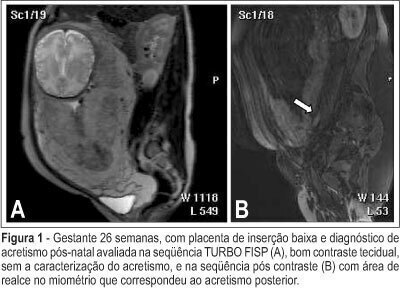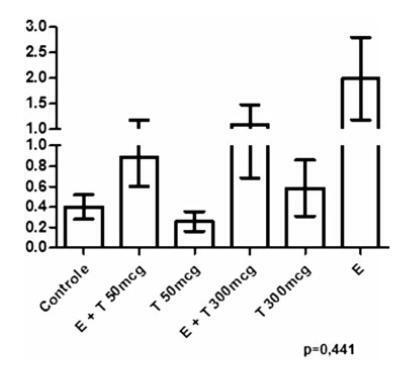Summary
Revista Brasileira de Ginecologia e Obstetrícia. 2002;24(1):70-70
DOI 10.1590/S0100-72032002000100015
Summary
Revista Brasileira de Ginecologia e Obstetrícia. 2011;33(2):70-74
DOI 10.1590/S0100-72032011000200003
OBJECTIVE: to correlate complaints of stress urinary incontinence and the results of a one-hour pad test in pre- and postmenopausal women. METHODS: cross-sectional study conducted on 60 postmenopausal volunteers divided into two groups: one consisting of 34 women with involuntary loss of urine due to stress incontinence and the other consisting of 26 women without involuntary loss of urine. A control group of 15 premenopausal women with normal menstrual cycles and no urinary complaints was also used. All women underwent clinical and laboratory analysis as well as the one-hour pad test. Patients were considered to be incontinent when sanitary pad weight post-test was more than 1 g. Data were submitted to descriptive statistics, parametric ANOVA, post-hoc Tukey test and Pearson's correlation. RESULTS: all postmenopausal women presented with stress urinary incontinence during the pad test, both those with urinary loss (4 g) and with no previous loss (3.5 g). A strong correlation was observed between urinary loss and time since menopause (r=0.8; p<0.01) and body mass index (r=0.7; p=0.01). Premenopausal women were continent during the pad test (0.4 g). CONCLUSIONS: the results of the one-hour pad test showed that all postmenopausal women exhibited stress urinary incontinence, including those without urine loss on effort. Urine loss was correlated with time since menopause and body mass index.
Summary
Revista Brasileira de Ginecologia e Obstetrícia. 2006;28(12):700-707
DOI 10.1590/S0100-72032006001200003
PURPOSE: to establish the main signs of placental accretism in magnetic resonance imaging (MRI) in patients with clinical suspicion and to estimate the benefit of this method. METHODS: prospective transversal study with 15 patients suspected of placental accretism, referred between March 2003 and February 2006. Gestational age varied from 20 to 31 weeks. All patients underwent MRI to study the placenta and had previously done an ultrasonography. Material was sent to histological study. MRI was done on Magnetom Impact and Sonata Maestro Class Siemens®, with acquired sequences HASTE, TURBO SPIN in axial, sagittal, coronal planes and echo gradient (GE®), pre- and post-dynamic contrast in the best plan for acquisition. Images were analyzed by a team of two radiologists. RESULTS: mean gestational age was 24.3 weeks. We studied seven placenta previa (47%), six anterior placentas (40%) and two posterior placentas (13%). Ultrasonography was positive in 80% of the palcentas and MRI in 53%. However, echography had a low concordance with anatomic pathological studies by Kappa test (11%), revealing 75% of sensitivity, 14% of specificity, 50% as positive predictive value (PPV) and 33% as negative predictive value (NPV). MRI had an excellent concordance with anatomic pathological studies (0.86), showing 100% of sensitivity, 86% of specificity, 89% as PPV and 100% as NPV. CONCLUSIONS: MRI is useful for placental accretism diagnosis. The principal findings are transmural hyper-signal, the loss of continuity in myometrial wall in fast sequences and the identification of vessels invading myometrial layer in dynamic sequences.

Summary
Revista Brasileira de Ginecologia e Obstetrícia. 2022;44(7):701-709
To analyze the influence of selenium in female fertility.
Selenium supplementation is promising in women with this micronutrient deficiency to promote improvement of the reproductive efficiency and prevent damage to the pregnancy. Further studies on this theme are still required.

Summary
Revista Brasileira de Ginecologia e Obstetrícia. 2004;26(9):703-707
DOI 10.1590/S0100-72032004000900005
PURPOSE: to analyze the association between modes of consecutive deliveries of 714 adolescents attended at the Maternity sector of the Hospital das Clínicas da Universidade Federal de Pernambuco (Federal University of Pernambuco), from January to December 2001. PATIENTS AND METHODS: according to a prospective, analytic, transversal, and incidence type study, the sequence of delivery modes was analyzed from the first to the fourth parturition of 714 pregnant adolescents, aged from 13 to 19 years (mean17.2±1.5 years). Every day, after identifying the adolescents who delivered, by the parturition room register, they were invited to participate in this study. Those who agreed, after signing a free informed consent answered a structured questionnaire with 65 direct questions with precodified closed options, among which were delivery mode and number of gestations. RESULTS: it was found that 527 (73.8%) adolescents had only one delivery, 149 (20.9%) two deliveries, 35 (4.9%) three deliveries, and 3 (0.4%) had had four deliveries. Among the 273 cesarean sections, 207 (75.8%) occurred in primiparae, 65 (23.8%) in secundiparae and one (0.4%) in a multipara. There was a statistically significant association between the first and the second deliveries for 83 (55.7%) adolescents who had transvaginal delivery, as well as for 41 (27.5%) by cesarean section. There was also coincidence about the second and third deliveries, regarding transvaginal delivery of 23 (65.7%) adolescents, as well as cesarean section of 10 (28.6%) adolescents. CONCLUSION: a tendency to coincidence of subsequent delivery modes was identified for adolescents until the third parturition.
Summary
Revista Brasileira de Ginecologia e Obstetrícia. 2019;41(12):703-709
To investigate the action of testosterone (T), isolated or associated with estradiol benzoate (EB), on the proliferation markers and apoptosis of breasts of ovariectomized rats.
A total of 48 castrated female Wistar rats were divided into 6 groups, and each of them were submitted to one of the following treatments for 5 weeks: 1) control; 2) EB 50 mcg/day + T 50 mcg/day; 3) T 50mcg/day; 4) EB 50 mcg +T 300 mcg/day; 5) T 300 mcg/day; and 6) EB 50 mcg/day. After the treatment, the mammary tissue was submitted to a histological analysis and immunoexpression evaluation of proliferation markers (proliferating cell nuclear antigen, PCNA) and apoptosis (caspase-3).
There was a statistically significant difference among the groups regarding microcalcifications and secretory activity, with higher prevalence in the groups treated with EB. There was no difference among the groups regarding atrophy, but a higher prevalence of atrophy was found in the groups that received T versus those that received EB +T. There was a difference among the groups regarding the PCNA (p = 0.028), with higher expression in the group submitted to EB +T 300 mcg/day. Regarding caspase-3, there was no difference among the groups; however, in the group submitted to EB +T 300 mcg/day, the expression was higher than in the isolated T group.
Isolated T did not have a proliferative effect on the mammary tissue, contrary to EB. Testosterone in combination with EB may or may not decrease the proliferation, depending on the dose of T.

Summary
Revista Brasileira de Ginecologia e Obstetrícia. 2003;25(10):703-703
DOI 10.1590/S0100-72032003001000001
Summary
Revista Brasileira de Ginecologia e Obstetrícia. 2020;42(11):705-711
To determine pregnancy outcomes in women with systemic lupus erythematosus (SLE) who were treated with hydroxychloroquine in a tertiary center.
A retrospective study involving pregnant women with SLE who had antenatal follow-up and delivery in between 1 January 2007 and 1 January 2017. All participants were retrospectively enrolled and categorized into two groups based on hydroxychloroquine treatment during pregnancy.
There were 82 pregnancies included with 47 (57.3%) in the hydroxychloroquine group and 35 (42.7%) in the non-hydroxychloroquine group. Amongst hydroxychloroquine users, there were significantly more pregnancies with musculoskeletal involvement (p = 0.03), heavier mean neonatal birthweight (p = 0.02), and prolonged duration of pregnancy (p = 0.001). In non-hydroxychloroquine patients, there were significantly more recurrent miscarriages (p = 0.003), incidence of hypertension (p = 0.01) and gestational diabetes mellitus (p = 0.01) and concurrent medical illness (p = 0.005). Hydroxychloroquine use during pregnancy was protective against hypertension (p = 0.001), and the gestational age at delivery had significant effect on the neonatal birthweight (p = 0.001). However, duration of the disease had a significant negative effect on the neonatal birthweight (p = 0.016).
Hydroxychloroquine enhanced better neonatal outcomes and reduced adverse pregnancy outcomes and antenatal complications such as hypertension and diabetes.